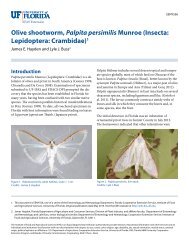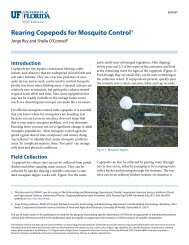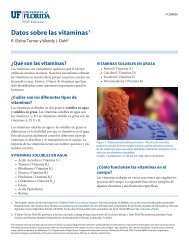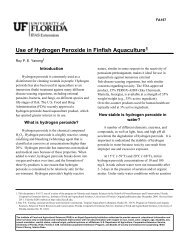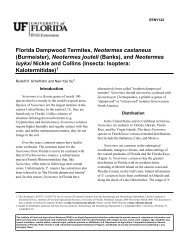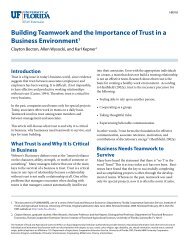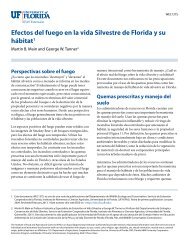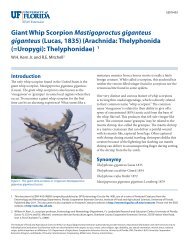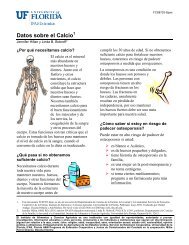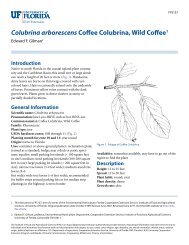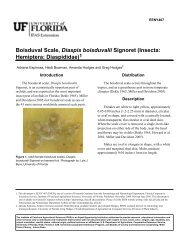Brown Recluse Spider, Loxosceles reclusa Gertsch and Mulaik ...
Brown Recluse Spider, Loxosceles reclusa Gertsch and Mulaik ...
Brown Recluse Spider, Loxosceles reclusa Gertsch and Mulaik ...
Create successful ePaper yourself
Turn your PDF publications into a flip-book with our unique Google optimized e-Paper software.
Weems <strong>and</strong> Whitcomb (1975) noted that, “on many occasions<br />
specimens have been inadvertently brought into<br />
Florida in trucks <strong>and</strong> automobiles, hidden in luggage,<br />
boxes, <strong>and</strong> various commercial cargoes, but to date it<br />
appears to have been unsuccessful in establishing breeding<br />
populations in Florida.” It is unfortunate that they did not<br />
document these alleged records, as this comment is not<br />
completely in accord with the following reference.<br />
An updated revision of the genus by <strong>Gertsch</strong> <strong>and</strong> Ennik<br />
(1983) reported a few records from Arizona, California,<br />
Colorado, Florida, Maine, Minnesota, New Jersey, New<br />
Mexico, New York, North Carolina, Wyoming <strong>and</strong> Tamaulipas<br />
(Mexico) [the reported Ontario (Canada) record<br />
in this publication subsequently proved to be a specimen<br />
of <strong>Loxosceles</strong> rufescens (Dufour); R. Vetter, personal<br />
communication, 2001]. Most of these peripheral records<br />
were interceptions of one or two specimens, not evidence<br />
of established populations. The Florida records consisted<br />
of two specimens, one each from Alachua (collected 10<br />
January 1969) <strong>and</strong> Jefferson (Monticello, collected 21<br />
August 1968) counties, <strong>and</strong> both were taken from inside<br />
automobiles. Subsequently, a sailor was bitten on the h<strong>and</strong><br />
by a male brown recluse in the cargo hold of a naval ship<br />
in Jacksonville, in March 1986. This ship had just arrived<br />
from North Carolina, where it had loaded supplies. To<br />
date, this appears to be the only verified case (the actual<br />
causative agent of a bite captured <strong>and</strong> identified) of brown<br />
recluse spider bite in Florida [due to complicating factors,<br />
medical personnel familiar with this case even questioned<br />
the veracity of this one alleged bite].<br />
Within the last two years, single buildings (in Callaway,<br />
Jacksonville <strong>and</strong> Tallahassee) have been found to contain<br />
populations of L. <strong>reclusa</strong> (Edwards 1999, 2000, 2001). There<br />
is reason to believe that all three of these records are the<br />
result of movement of infested materials from other states,<br />
so it is entirely possible that the infestations are restricted<br />
to these buildings <strong>and</strong> can be eliminated. Such was the<br />
case with an infestation of the similar L. rufescens found<br />
in Orange County (DPI records from Orl<strong>and</strong>o: 28 January<br />
1982, 4 January 1983 <strong>and</strong> 18 August 1986) in a single<br />
building; the spiders were subsequently eradicated.<br />
The only other records of L. rufescens occurring in Florida<br />
are a few juvenile spiders in buildings in nearby Osceola<br />
County (Runnymede; Banks 1904) <strong>and</strong> one juvenile<br />
specimen from Dade County (Lemon City; <strong>Gertsch</strong><br />
1958). This cosmopolitan species is probably native to<br />
the Mediterranean region, <strong>and</strong> is sometimes called the<br />
Mediterranean brown spider or Mediterranean recluse. It<br />
has been recorded from a number of localities across the<br />
U.S., particularly in larger cities, where it is transported by<br />
commerce (<strong>Gertsch</strong> <strong>and</strong> Ennik 1983).<br />
In summary, the verified records of brown recluse <strong>and</strong><br />
related spiders in the state are limited to the following eight<br />
out of 67 Florida counties: Alachua, Bay (Callaway), Dade<br />
(Lemon City), Duval (Jacksonville), Jefferson (Monticello),<br />
Leon (Tallahassee), Orange (Orl<strong>and</strong>o) <strong>and</strong> Osceola<br />
(Runnymede). The more northern counties (Alachua,<br />
Bay, Duval, Jefferson <strong>and</strong> Leon) were all isolated records<br />
of the native brown recluse, L. <strong>reclusa</strong>, whereas the more<br />
southern county records (Dade, Orange <strong>and</strong> Osceola) were<br />
of the introduced Mediterranean recluse, L. rufescens. The<br />
Alachua, Dade <strong>and</strong> Jefferson county records were interceptions<br />
of single specimens. The Bay, Duval, Leon, Orange<br />
<strong>and</strong> Osceola county records were infestations in one or two<br />
buildings. There is no evidence to support either the notion<br />
that a widespread population of brown recluse spiders<br />
exists in Florida or that there are numerous introductions<br />
of brown recluse into the state. Therefore, there is no reason<br />
to assume that frequent interactions between brown recluse<br />
<strong>and</strong> humans occur in Florida. Subsequent to the original<br />
publication of this work (as a DPI Entomology Circular),<br />
L. rufescens was found in a warehouse in Escambia County,<br />
Florida; <strong>and</strong> <strong>Loxosceles</strong> laeta (Nicolet), the Chilean recluse<br />
spider, was found in a home in Polk County, Florida<br />
(Edwards 2002a).<br />
I have personally identified several hundred Florida spiders<br />
submitted for identification by the public, <strong>and</strong> only one<br />
specimen (the Bay County record) proved to be a brown<br />
recluse spider. In addition, I have seen thous<strong>and</strong>s of Florida<br />
spiders submitted by professional biologists <strong>and</strong> inspectors,<br />
with only the few specimens mentioned above proving to<br />
be members of the genus <strong>Loxosceles</strong>. It appears obvious to<br />
me that the chance of interaction between brown recluse<br />
spiders <strong>and</strong> people in Florida is close to nil, agreeing with<br />
Vetter’s (2000) assessment of reported brown recluse bites<br />
outside the natural range of the spider. Medical personnel<br />
should, therefore, consider a multitude of more likely<br />
causes (see below) before diagnosing <strong>and</strong> treating a necrotic<br />
wound as a brown recluse bite.<br />
Description<br />
The description is taken from <strong>Gertsch</strong> (1958). Adults of<br />
both sexes are similar in appearance <strong>and</strong> size, ranging from<br />
about 7 to 12 mm in body length. Adult females average<br />
slightly larger, about 9 mm compared to about 8 mm for<br />
adult males. The carapace is pale yellow to reddish brown,<br />
with a dusky brown patch just in front of the median groove<br />
(which is encompassed by a narrow, dark line); this patch is<br />
2



